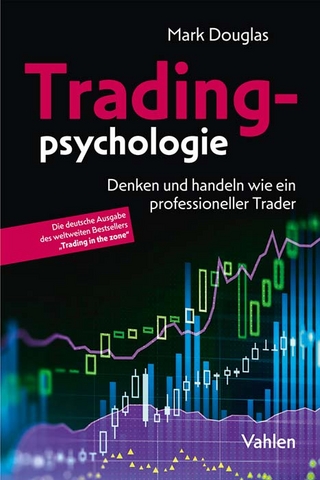
A Decade of Armageddon
Spiramus Press (Verlag)
978-1-910151-58-7 (ISBN)
This as-it-happened review of the causes, consequences, and repercussions of the 2008 Global Financial Crisis is more than a history lesson – it's a look into the future.
These essays by Dr Susanne Trimbath, were first published between 2008 and 2015 on newgeography.com. They have been edited to be read as a free-standing publication, grouped together into the following chapters:
Bailouts
Congressional Hearings and Legislation
Homeowners and Mortgages
Federal Reserve and Treasury Actions
Bank/Broker Behavior
Systemic Issues
Public Reaction
The hardback is a limited edition of 100 copies, signed by the author. Every copy sold will include a US$5 donation to the Diane Fossey Foundation
Susanne Trimbath holds a Ph.D. in Economics from New York University and received her MBA in Management from Golden Gate University. Prior to forming STP Advisory Services, Dr. Trimbath was Senior Research Economist in Capital Studies at Milken Institute (Santa Monica, CA) and Senior Advisor on the Russian Capital Markets Project (USAID-funded) with KPMG in Moscow and St. Petersburg. She started her career in financial services operations at the Federal Reserve Bank of San Francisco. Since 1989, Dr. Trimbath has taught economics and finance in university graduate and undergraduate programs as adjunct, associate and full-time professor. Dr. Trimbath helped create the Transportation Performance Index for the U.S. Chamber of Commerce (Washington, D.C.) which she used to demonstrate the real economic payoff of investments in infrastructure. Dr. Trimbath authored, edited and contributed chapters to five books, including Mergers and Efficiency (2002), Beyond Junk Bonds (2003), and Methodological Issues in Accounting Research (2006). Her media credits include appearances on national television and radio programs (CNBC's Power Lunch and NPR's Marketplace) and the Bloomberg report Phantom Shares. Dr. Trimbath's articles appear in the national publications US Banker, The International Economy, and The American Enterprise in addition to academic, peer-reviewed journals. Dr. Trimbath is a contributing editor at NewGeography.com.
1. Bailouts
Why there were bailouts in 2008-9 for Wall Street and not for Main Street? This chapter includes articles on who got the money and how the true cost, which was to be borne by US taxpayers, was hard to calculate and often purposefully hidden from public view.
2. Congressional Hearings and Legislation
Once the full-blown global financial crisis hit, the response included tens of thousands of pages of new rules, regulations and regulators in the space of about three years. Also, the US government assumed ownership and operation of AIG. This was the first "taking" since 1989 and was followed by Washington Mutual in September 2008 and W Holding's Westernbank in April 2010.
3. Homeowners and Mortgages
The housing market, in the years leading up to the financial crisis and the Great Recession, had been treated like gold – not that "houses are as good as gold" but that people were treating houses AS IF they were an investment and not a place to live.
4. Federal Reserve and Treasury Actions
In 2009, Treasury Secretary Timothy Geithner presented a proposal for legislation that would give the secretary the authority to make the final determination that a financial institution on the verge of default – regulation by revolution. Geithner's proposal would let the federal government nationalize a 'too big to fail' company.
5. Bank/Broker Behavior
The actions of financial industry professionals led to the financial crisis that developed into the Great Recession. Criminal charges were brought against those who cheated their way into getting a share of the bailout money, but many of those responsible for creating the situation were paid elaborate bonuses at the same time their financial institutions were receiving bailout funds.
6. Systemic Issues
This chapter on Systemic Issues goes into detail about topics that are widely misunderstood by the non-financial public: financial innovations were supposed to democratize capital by making it easier to fund less-popular projects, both public and private. Like many inventions, it was abused for the enrichment of a few.
7. Public Reaction
Public reaction in the United States to the revelations of the Wall Street bailout was subdued. A Landmark Narrative developed and was generally accepted by Americans: people bought houses they couldn't afford by using adjustable-rate mortgages, no-money-down and other schemes offered by banks. When the favorable terms ran out those homebuyers stopped paying their mortgages; they caused their mortgage bank to slide toward bankruptcy, and caused all those "sliced-and-diced" mortgage-backed bonds to fail, too.
| Erscheinungsdatum | 03.02.2024 |
|---|---|
| Verlagsort | London |
| Sprache | englisch |
| Maße | 156 x 234 mm |
| Gewicht | 145 g |
| Themenwelt | Wirtschaft ► Betriebswirtschaft / Management ► Finanzierung |
| Betriebswirtschaft / Management ► Spezielle Betriebswirtschaftslehre ► Bankbetriebslehre | |
| Wirtschaft ► Volkswirtschaftslehre ► Finanzwissenschaft | |
| ISBN-10 | 1-910151-58-0 / 1910151580 |
| ISBN-13 | 978-1-910151-58-7 / 9781910151587 |
| Zustand | Neuware |
| Haben Sie eine Frage zum Produkt? |
aus dem Bereich


